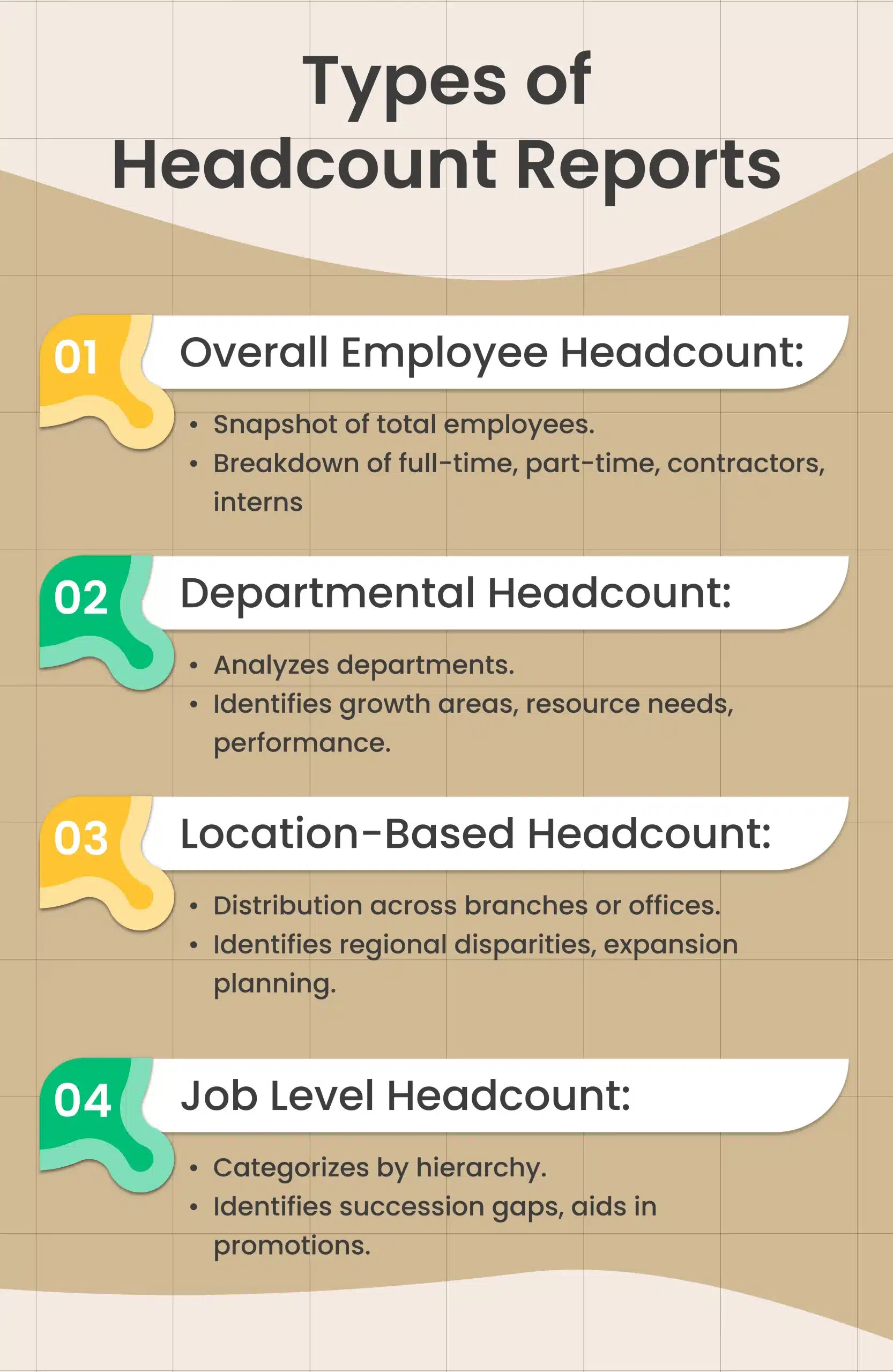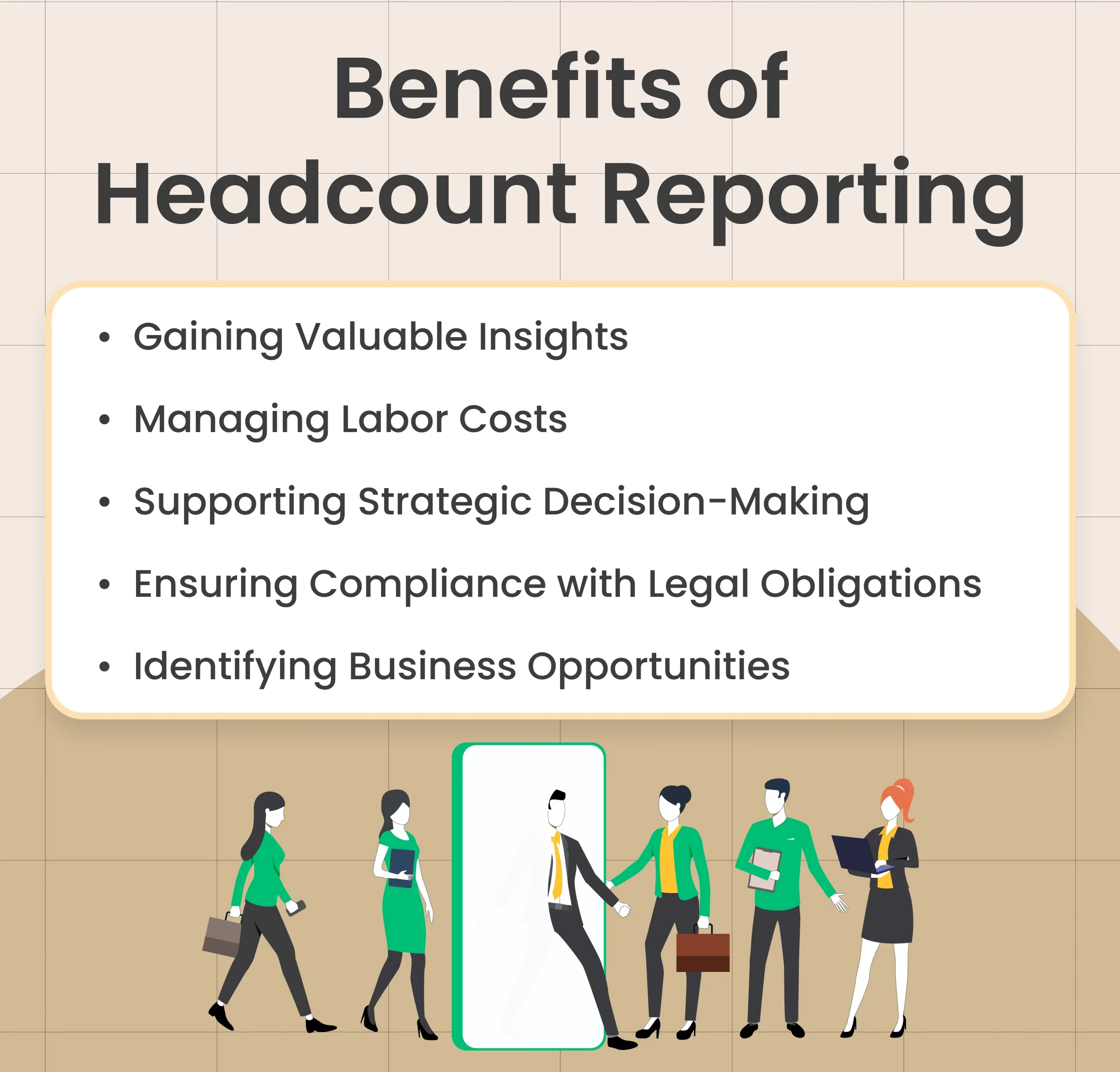Table of content
What is Headcount Reporting?
Headcount reporting plays a crucial role in modern business operations by providing organizations with valuable insight into their workforce. Essentially, it refers to the process of gathering and analyzing data related to the number of individuals employed by a company at a given time. This data includes information about the types of employees, such as full-time or part-time, as well as their employment status and benefits.
Accurate reporting is an important step in understanding a company’s current workforce and planning for the future. It allows organizations to identify trends, measure their human resource performance, and develop effective strategies for recruitment, retention, and career advancement. Additionally, it enables HR leaders to assess the impact of hiring practices, employee classification, and changes in headcount on the company’s success.
What are the Benefits of Headcount Reporting?
Implementing effective headcount reporting practices can offer numerous advantages for organizations. By leveraging accurate and timely headcount reports, businesses can gain valuable insights, manage labor costs, and support strategic decision-making. Here are its key benefits:
Gaining Valuable Insights
Headcount reports provide valuable information about the organization’s workforce, including the total number of employees, their roles, and employment statuses. This data allows businesses to understand their human resources better and make informed decisions regarding recruitment, training, and employee development.
Managing Labor Costs
Effective headcount reports enable businesses to track and manage labor costs more efficiently. By analyzing the data, organizations can identify trends, monitor overtime expenses, and optimize staffing levels to maintain productivity while minimizing unnecessary expenses.
Supporting Strategic Decision-Making
Headcount report plays a vital role in supporting strategic decision-making processes. They provide quantitative information about the workforce, allowing organizations to align their human resources with long-term business objectives. This helps in workforce planning, identifying skill gaps, and making informed decisions about resource allocation.
Ensuring Compliance with Legal Obligations
Accurate headcount reporting is crucial for ensuring compliance with various legal obligations related to employment. By maintaining up-to-date and comprehensive headcount reports, organizations can demonstrate compliance with labor laws, health care benefit regulations, and other employment-related obligations.
Identifying Business Opportunities
Headcount reports not only provide a snapshot of the organization’s current workforce but can also reveal growth opportunities. By analyzing the headcount data over time, organizations can identify patterns and trends, helping them identify areas where additional resources or restructuring may be necessary to seize new business opportunities.
Best Practices for Headcount Reporting
Accurate and efficient reporting is crucial for businesses to manage their workforce effectively and make informed decisions. By implementing the following best practices, organizations can ensure that their headcount reports provide valuable insights and support strategic decision-making.
Identify Reliable Data Sources
When preparing headcount reports, it is essential to gather data from reliable sources. This includes HR databases, payroll systems, and employee records. By using up-to-date and accurate information, organizations can trust the validity of their headcount reports.
Categorize Employees
Categorizing employees based on different criteria, such as employment status, job role, or department, allows for better analysis and understanding of the workforce. This categorization helps identify trends, patterns, and potential areas of improvement.
Ensure Legal Compliance
Compliance with employment laws and regulations is crucial in headcount reporting. Organizations must accurately classify employees based on legal definitions and standards. This includes correctly categorizing employees as full-time, part-time, or contractors, adhering to local labor laws, and accounting for changes in employment status.
Maintain Consistency Over Time
To analyze workforce trends and patterns accurately, it is essential to maintain consistency when capturing data over time. Consistent categories, definitions, and reporting formats ensure meaningful comparisons and enable organizations to identify long-term changes and patterns.
Regularly Review and Update Data
Headcount reports should be regularly reviewed and updated to ensure the accuracy and reliability of the information. This includes removing outdated or redundant data, correcting any errors or discrepancies, and incorporating the latest workforce changes.
Use Visualizations for Clarity
Presenting headcount data in visual formats, such as charts or graphs, enhances clarity and improves the understanding of the information. Visualizations can highlight trends, comparisons, and outliers, making it easier for stakeholders to grasp the key insights at a glance.
Align Headcount Reporting with Business Objectives
Headcount reports should be aligned with the organization’s strategic objectives and goals. By analyzing data in the context of business objectives, organizations can identify gaps, opportunities, and potential solutions to drive better performance.
Foster Collaboration between HR and Finance
Collaboration between HR and finance departments is crucial for accurate reporting. By aligning HR’s understanding of workforce dynamics with finance’s budgetary requirements, organizations can develop comprehensive and impactful headcount reports.
How to Leverage Headcount Data for Future Planning?
Headcount data plays a crucial role in guiding organizations’ future planning strategies, as it offers valuable insights into workforce composition and trends. By analyzing headcount data, businesses can make informed decisions, allocate resources effectively, and identify growth opportunities. Here’s how the data can be leveraged for headcount forecasting and future planning, aiding in budgetary decision-making and strategic initiatives.
Forecasting Workforce Needs
Headcount data provides quantitative information about the number and composition of employees within an organization. By analyzing historical trends and projected business goals, companies can forecast their future workforce needs. This involves estimating the required number of employees, identifying skill gaps, and anticipating hiring requirements.
Budgetary Decision-Making
Effective budgeting is crucial for financial stability and resource allocation. Headcount data enables organizations to assess the budgetary impact of changes in employee headcount and labor costs. By examining historical data and forecasting future requirements, businesses can make informed decisions on compensation, benefits, and workforce investments.
For instance, if headcount data reveals a high turnover rate, it may indicate the need to allocate resources towards employee retention initiatives.
Identifying Growth Opportunities
Headcount data provides insights into the growth trajectory of an organization. By analyzing data on employee classifications and departments, businesses can identify areas of high growth potential and allocate resources accordingly.
For instance, if a particular department has a higher headcount growth rate, it may suggest a need for additional investment in resources, skills, or technology to support that department’s expansion.
Conclusion
In conclusion, effective headcount reporting is crucial for organizations aiming to achieve better business performance and success. By implementing best practices and strategies, businesses can gain valuable insights, manage labor costs, and make informed decisions that align with their objectives.
Through accurate and efficient reporting, organizations can optimize their workforce planning, ensuring that their human resources are aligned with their business goals. This enables them to make budgetary decisions, identify growth opportunities, and forecast future needs.





